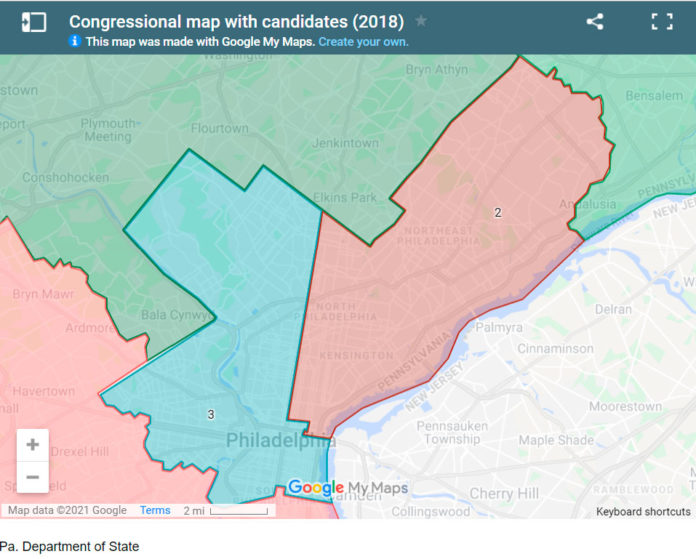The first proposed Pennsylvania congressional map was released by PA House Republicans on Wednesday, December 8, kicking off a process of discussion and negotiation that will lead to finalization of new district lines in the coming weeks. According to a Philadelphia Inquirer report released on the same day, “Pennsylvania is expected to have several competitive congressional elections that will help determine which party controls the U.S. House, making the new [maps] critical in shaping political power.”
This is just one of several maps that will be redrawn and finalized in the coming days and weeks. While the state government is responsible for drafting new lines for the US House of Representatives districts, they are also tasked with drawing new lines for the State House of Representatives and the State Senate. According to various sources, Governor Wolf has indicated a deadline of January 24th for approval of the US congressional districts map. First, the PA House of Representatives and State Senate must each vote to approve the proposed map, and then it is sent to the Governor, who can veto it and send it back to the legislative bodies to make revisions. There is no indication yet as to when state-level maps may be proposed, negotiated, and finalized.
As a reminder of the general priorities and interest of Hispanic North Philadelphia: New maps should reflect the movements of different demographic groups over the last ten years – including ethnic, cultural, political, etc – by keeping them together as much as possible, rather than fracturing and dividing them. The US congressional districts have a stronger impact on the makeup of Pennsylvania’s representation in Congress, rather than reflecting granular populations at the local level in Philadelphia, since there are only 17 US congressional districts in Pennsylvania. The power of this map, therefore, resides in its ability to determine if Pennsylvania sends a Republican or a Democratic majority to the US Congress, to represent Pennsylvanians among the 435 total representatives from across the country. However, small shifts at local levels can shift the balance of power. Additionally, because of shifts shown in the 2020 Census, Pennsylvania’s 18 previous districts will be reduced to 17. Consequently, Pennsylvania will also lose one electoral vote in future Presidential elections, since the electoral votes are based on the number of US Representatives each state has. Several years ago, this was predicted to happen (in an analysis by Election Data Services) – Pennsylvania’s population has fallen as a percentage of the total US population (even if years of population growth in Pennsylvania, other states are growing faster), and Pennsylvania has lost at least one congressional seat every ten years since it peaked at 36 in 1920. This creates even tighter competition for political sway.

The two maps included here as Exhibit 1 and Exhibit 2 are zoomed in to show the US Congressional districts of Philadelphia. Exhibit 1 is the current map of district boundaries, established by the PA Supreme Court in 2018 following the legal battle over the gerrymandered maps produced in 2011. Exhibit 2 is the map put forward by the PA House Republicans. Nineteen “citizen maps” were submitted by the public (either individuals or groups/organizations), and the one selected was created by the former Lehigh County Republican Commissioner, Amanda Holt. Ms. Holt was active a decade ago in advocacy efforts to create fairer districts, after her realization that voters in her own county were unfairly divided.
So, is Ms. Holt’s map considered fair? Elected officials and advocacy groups acknowledge that her map is meant to serve as a starting point for negotiations that will likely take several weeks. It is unlikely that the map would be finalized exactly as Ms. Holt has drawn it. Still, as a basis for negotiation, independent analysts find some flaws in the proposed map. Dave’s Redistricting App (an open-source data and mapping tool) labels the map “anti-majoritarian,” because in a hypothetical election, Democrats would be projected to win 52.3% of total votes but only 47.4% of available seats. Another nonpartisan data analytics group called the Princeton Gerrymandering Project estimates this map has an 8.8% partisan bias in favor of Republicans. At our local level in Philadelphia, the map proposes to carve out a section of Northeast Philadelphia (north of Roosevelt Blvd) and remove it from the 2nd Congressional District. The numbers of voters lost from this carve-out are then proposed to be replaced with a section of downtown Philadelphia being added to the district. This not only reduces the “compactness” required by district maps, but also aims to create an unfair advantage for suburban districts by grouping some northeast Philadelphia voters in a largely suburban district. Also, this gerrymandered carve-out would divide and isolate Latinos in northeast Philadelphia from their neighbors. Latinos are continuing to move further northeast in larger numbers every year, and that gerrymandered section would be comprised of Latinos whose votes would be diluted in the suburban non-Latino population.
Although this map will not be the final one, it is important for communities to begin advocating for themselves as the negotiations get underway. The next few weeks will be a critical time for the input of voters and advocacy groups to be taken into account by legislatures and the Governor. If Impacto readers have questions or want to get involved in this important dialogue, please contact Esperanza at 215-324-0746 or email Quetcy Lozada at qlozada@esperanza.us.






















